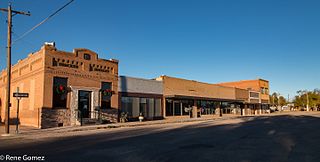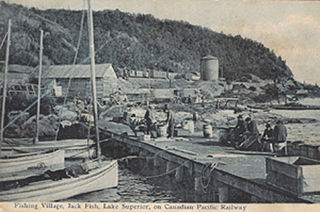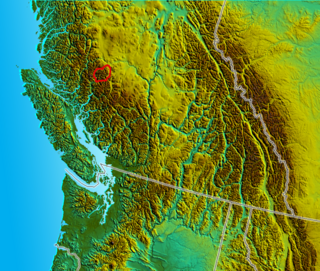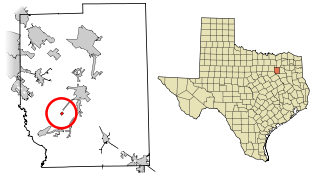Related Research Articles

Hardeman County is a county located in the U.S. state of Texas. As of the 2020 census, its population was 3,549. The county seat and largest city is Quanah. The county was created in 1858 and later organized in 1884. It is named for two brothers, Bailey Hardeman and Thomas Jones Hardeman, early Texas politicians and legislators. Hardeman County was one of 46 prohibition or entirely dry counties in the state of Texas until November 2006, when voters approved referendums to permit the legal sale of alcoholic beverages for on- and off-premises consumption.

Cockeysville is a census-designated place (CDP) in Baltimore County, Maryland, United States. The population was 20,776 at the 2010 census.
Wilburton is a city in Latimer County, Oklahoma, United States. It is the county seat of Latimer County. The city had a population of 2,285 as of the 2020 Census. Robbers Cave State Park is 5 miles (8.0 km) north of Wilburton.

Henrietta is a city in and the county seat of Clay County, Texas, United States. It is part of the Wichita Falls metropolitan statistical area. The population was 3,141 at the 2010 census, a decline of 123 from the 2000 tabulation of 3,264.

Ennis is a city in eastern Ellis County, Texas, United States. The population is 20,159 according to the 2020 census, with an estimated population of 21,210 in 2021. Ennis is home to the annual National Polka Festival.
Tom Bean is a city in Grayson County, Texas, United States. The population was 1,045 at the 2010 census, up from 941 at the 2000 census.

Roaring Springs is a town in Motley County, Texas, United States. The population was 265 at the 2000 census.

Quanah Parker was a war leader of the Kwahadi ("Antelope") band of the Comanche Nation. He was likely born into the Nokoni ("Wanderers") band of Tabby-nocca and grew up among the Kwahadis, the son of Kwahadi Comanche chief Peta Nocona and Cynthia Ann Parker, an Anglo-American who had been abducted as an eight-year-old child and assimilated into the Nokoni tribe. Following the apprehension of several Kiowa chiefs in 1871, Quanah Parker emerged as a dominant figure in the Red River War, clashing repeatedly with Colonel Ranald S. Mackenzie. With European-Americans hunting American bison, the Comanches' primary sustenance, into near extinction, Quanah Parker eventually surrendered and peaceably led the Kwahadi to the reservation at Fort Sill, Oklahoma.

Nickel Centre was a town in Ontario, Canada, which existed from 1973 to 2000.

Jackfish is a ghost town in northern Ontario, Canada, located on the north shore of Lake Superior east of Terrace Bay.

The Niut Range is 3600 km2 in area. It is a subrange of the Pacific Ranges of the Coast Mountains of British Columbia, although in some classifications it is considered part of the Chilcotin Ranges. The Niut is located in the angle of the Homathko River and its main west fork, Mosley Creek. It is isolated, island-like, by those rivers from its neighbour ranges, as both streams have their source on the Chilcotin Plateau in behind the range. Razorback Mountain is its highest peak.

Scurry is a town in Kaufman County, Texas, United States. It was incorporated in 2003. As of the 2010 census, it had a population of 681.

Quindaro Townsite is a former settlement, then ghost town, and now an archaeological district. It is around North 27th Street and the Missouri Pacific Railroad tracks in Kansas City, Kansas. It was placed on the National Register of Historic Places on May 22, 2002.

Betteravia was a community in northern Santa Barbara County, California on Betteravia Road, six miles west of Santa Maria. It is notable as a rare ghost town on the Central Coast of California.
The Choctaw, Oklahoma and Gulf Railroad (CO&G), known informally as the "Choctaw Route," was an American railroad in the states of Arkansas and Oklahoma.

Lobo is a ghost town in Culberson County, Texas, United States, that was abandoned in 1991.

Quanah, Acme and Pacific Railway (QA&P) was a 117-mile (188 km) freight railroad that operated between the Red River and Floydada, Texas, from 1902 until it was merged into the Burlington Northern Railroad in 1981.
Hotze "Harry" Koch was a Dutch-born American businessman who founded the Quanah Tribune-Chief newspaper. He was the father of Fred C. Koch (1900–1967), founder of Koch Industries.
Acme is a ghost town in Hardeman County, Texas, United States. It is located five miles west of the county seat, Quanah.

Pantano is a ghost town located in eastern Pima County, Arizona, between Benson and Vail. Access is via the Marsh Station Road interchange on I-10. It was established as a small railroad town with the arrival of the Southern Pacific in 1880, supplanting the earlier Ciénega station that was located to the west of Pantano.
References
- 1 2 3 Hofsommer, Donovan L. (Winter 1979). "Town Building on a Texas Short Line: The Quanah, Acme & Pacific Railway 1909–1929". Arizona and the West. 21 (4): 355–368.
- ↑ Davis, Charles. "Narcisso, TX". tshaonline.org. Texas State Historical Association . Retrieved October 12, 2023.
